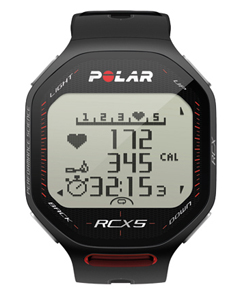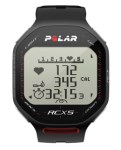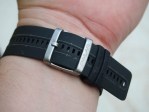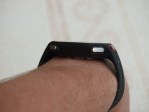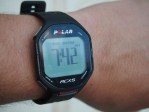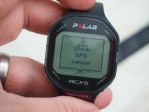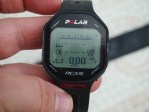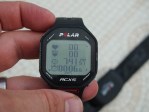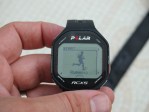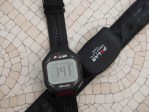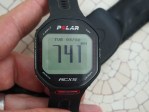I’ve used quite a few heart rate monitoring watches in my day. I’ve played with Suuntos and Nikes aplenty, with whosits and whatsits galore. But the RCX5 is different in its utter simplicity. Designed to be worn while swimming, running, or biking, all of the smarts are actually in the optional sensors, leaving the watch itself as basic as a $20 Timex with a few tricks up its sleeve.
The base kit – that is, the watch, heart rate band, and a battery – costs $349. Although the watch and sensors are ostensibly OS X and Windows compatible, you’re going to be more comfortable using the software on Windows. I had some issues with the Mac sync and it wouldn’t work at all for me using a MacBook Air. It did work on my Mac Pro at home.
The extra gear costs, well, extra, although different packages – Run, Bike, Multi – add more than $100 to that price on the high end. To be clear, this watch is a major investment. The watch supports the Polar bike cadence and speed sensors, running pedometers, and GPS units. The heartrate monitor is water resistant as is the watch so you can wear it in all sorts of situations.
The battery lasts about six to eight months of regular use, which can be attributed to the watch’s dependence on radio communications. This is a far sight better, however, than most rechargeable models.
The things that stand out the most for me with this unit is the size, compact shape, and simplicity. Rather than cruft up the UI with “ghost running partners” and “time to exercise” reminders – although those are useful in some cases – this watch is no nonsense. The goal is to strap it on, do your training, be it biking, running, or swimming, and then look at the results. It’s a real sports watch in that it doesn’t want to help you loose weight or meet friends in the park for a jog. It wants to make you a machine.
To use it you simply strap everything to your body or bike, press the red “go” button to select a sport, and then press it again to start recording. You can also run pre-set workouts that you define in software. There are multiple activity readouts including a screen that shows current heart rate level (in comparison to the ideal) as well as speed, cadence, and distance. You can also set a special “gesture:” bringing your watch up to your heart rate monitor sets the watch to a different screen momentarily, a screen that you can preset. For example, you could set it to show you current time or distance and then drop back down to a read-out that focuses on heart rate.
DC Rainmaker has a video:
Once you have the watch, however, you need the accessories. It’s this upsell that may peeve some watch owners used to having an all-in-one solution although, I’d warrant, this looks better with a dress shirt that any of the monstrous GPS watches Garmin offers. Because this watch is only as good as its complementary sensors, so we’ll address those one by one.
Cadence sensors (bikes) – I tested the $30 CS speed sensor W.I.N.D. and the complementary $30 cadence sensor on my bike and got strong, consistent readings. Installation is a snap – you just place the sensor on one part of the bike and a little magnet on the other (placement varies). The sensors are small enough to be unobtrusive and are water resistant.
GPS – I also tested the small G5 GPS sensor, a device about the size of an iPod Nano that acted as a GPS antenna. It picked up a strong signal in New York and, surprisingly, also picked up a nice signal in Poland after about 30 minutes of searching. This small sensor comes with an arm band and is rechargeable via USB. Precision was strong – once the device achieved a satellite lock – but moving to a new location required another lengthy search process.
Foot pod – I tried the $113 s3+ stride sensor that connects to your shoe and senses current stride and footfall. I found this to be far more convenient than the GPS unit although slightly less precise.
Heart rate monitor – The standard model was comfortable, unobtrusive, and water resistant. It worked fine in all situations and I often forgot I was wearing it.
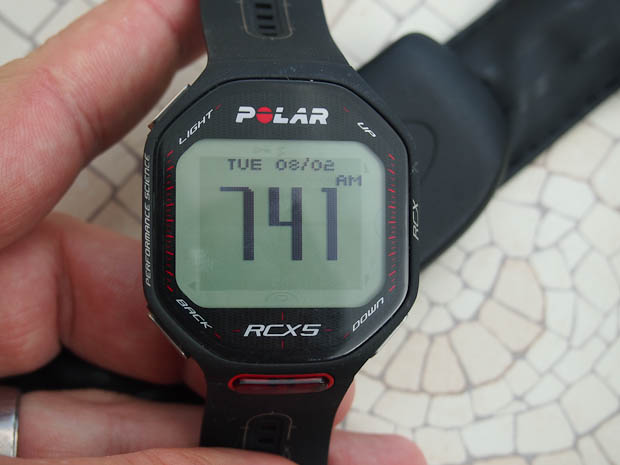
I’m away from my main computer and was unable to synchronize the watch with my Mac on this trip but here is a screen from the workout designer, a system for creating special interval workouts with a set speed and heart rate. You can also upload ready-made workouts to the watch and, for example, perform a set of intervals based on your specific goals.
If you’re looking for endurance-specific features, the RCX5 has them in spades. To be clear, I’m a big fat blogger so I can’t address the actual utility of these tools so I’ll paste them verbatim here for you to peruse. That said, I can state that this watch is different in that it definitely offers far more data than I’ve ever seen from a standard “runner’s” watch. Will it inspire me to do an Ironman? Probably not, but a boy can dream.
Sport Profiles: Essential for multisport and triathletes, this feature enables users to quickly switch between sports during training. With just a few button presses, this feature quickly adjusts settings to the current sport. It automatically detects any sensors needed, so that no time or training data is lost between swims, rides or runs. Four sport profiles come pre-loaded into the RCX5, and more can be added based on the user’s preferences.
ZoneOptimizer: Knowing how hard to train can be a challenge and it depends on many factors, including physical and mental state, stress, sleep, and previous training. The brand new ZoneOptimizer feature eliminates guesswork by adjusting personal heart rate zones based on a user’s current physiological condition. It guides training at the right intensity, making every session more effective.
Race Pace: The perfect feature for regulating speed and race strategy, Race Pace allows users to set a target time for a certain distance, and then displays the current pace/speed, as well as how far ahead or behind the user is from the target.
Training Load: This feature within polarpersonaltrainer.com displays a color-coded graph of a user’s cumulative training load, notifying a person when he or she has recovered enough for the next session, and accurately predicting training developments to prevent overtraining. This data also provides intelligence to modify training sessions as necessary.
polarpersonaltrainer.com: Several upgrades have been incorporated into the free online training journal to support the RCX5 users. Users can now create complete endurance training programs for running and cycling, including warm-up, work and cool-down sessions. The training programs can be easily synched to the RCX5 via the DataLink data transfer unit. After each session, it is easy to track progress online over time.
![image[6]](https://techcrunch.com/wp-content/uploads/2011/08/image6.png)
I’m obviously coming at this from the perspective of a dilettante so I’d recommend you also check out this exhaustive review by DC Rainmaker. For the average weekened runner, however, I think this watch may be a little too powerful and a little too expensive. While I wouldn’t recommend the Nike+ GPS watch for city-dwellers, it works just fine and Garmin has always pleased me with their self-contained heart rate/GPS watches.
Is this the watch for a weekend warrior? Probably not. It’s pricey, complicated, and oftentimes overkill. However, is this the watch for a serious triathlon trainee with a geek’s love of numbers? Absolutely.
Product Sets
RCX5 Bike (MSRP $389.95):
RCX5 training computer
WearLink®+ Hybrid transmitter
CS speed sensor W.I.N.D.
DataLink data transfer unit
Getting Started GuideRCX5 Run (MSRP $419.95):
RCX5 training computer
WearLink®+ Hybrid transmitter
s3+ stride sensor
DataLink data transfer unit
Getting Started GuideRCX5 Multi (MSRP $469.95)
RCX5 training computer
WearLink®+ Hybrid transmitter
G5 GPS sensor
DataLink data transfer unit
Getting Started GuideRCX5 Basic Set (MSRP $349.95) (Available July 2011):
RCX5 training computer
WearLink®+ Hybrid transmitter
DataLink data transfer unit
Getting Started Guide
